#Angular diameter
Text
All right if you see this post put in the tags a list of all the Wikipedia pages you have open in your tabs no matter how long they've been there
#Neutron bomb#The Maltese Falcon (1941 Film)#Angular diameter#Patriots' Day#Dodo#Mark of the Vampire (1935 Film)#Reinforced concrete
2K notes
·
View notes
Photo

the main characters or whatever :P
mainly just wanted to get a handle on the art style.
#SPOP#She-Ra#Glimmer#Adora#she ra adora#she ra Bow#i cant believe its not spelled Beau#also wow Etheria has a LOT of moons. i will be mapping them at some point.#and i reserve the right to interpret them with more reasonable angular diameters and phases and etheriashine than presented in the show
178 notes
·
View notes
Text
Interesting science fact that seems like witchcraft:
If something is far enough away, it actually looks bigger, because the light that's just now reaching you from it dates back to when the universe was smaller.
1 note
·
View note
Text



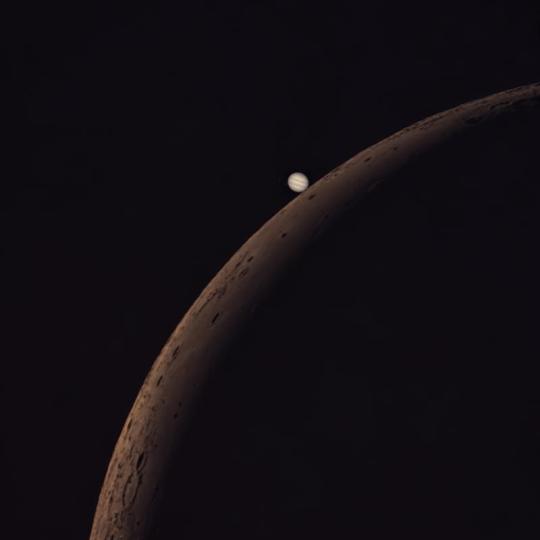
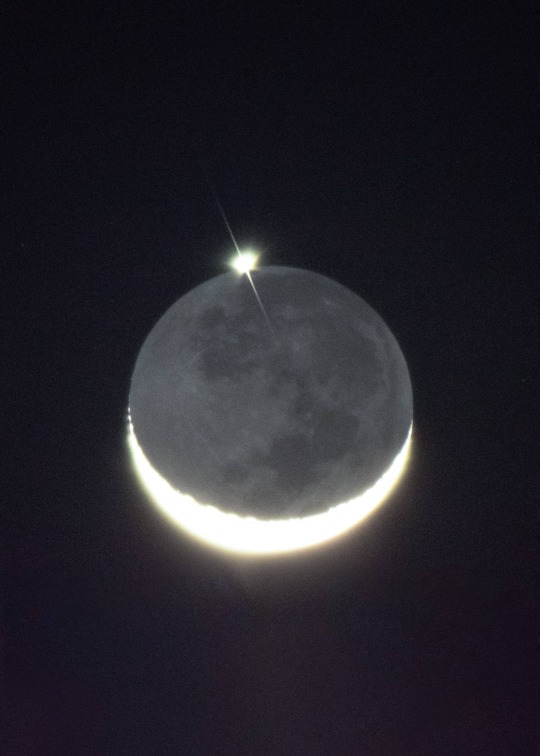


Occultations by the Moon
The term occultation is most frequently used to describe lunar occultations, those relatively frequent occasions when the Moon passes in front of a star during the course of its orbital motion around the Earth. Since the Moon, with an angular speed with respect to the stars of 0.55 arcsec/s or 2.7 μrad/s, has a very thin atmosphere and stars have an angular diameter of at most 0.057 arcseconds or 0.28 μrad, a star that is occulted by the Moon will disappear or reappear in 0.1 seconds or less on the Moon's edge, or limb. Events that take place on the Moon's dark limb are of particular interest to observers, because the lack of glare allows easier observation and timing.
The accurate timing of lunar occultations is performed regularly by (primarily amateur) astronomers. Lunar occultations timed to an accuracy of a few tenths of a second have various scientific uses, particularly in refining our knowledge of lunar topography.
source
image credit: Tom Fleming, Elias Chasioti, Delberson Souza, Bob Schiff, Fausto Lubatti, Sergio Scauso
875 notes
·
View notes
Text

Rampaging Fronts of the Veil Nebula - March 7th, 1996.
"A supernova explosion of a high-mass star results in fast moving blast waves. At the front of the waves shown above, ionised gas in the Veil Supernova Remnant rushes out from the explosion, sweeps up material, and breaks up many atoms into constituent ions and electrons. Observations with the Hubble Space Telescope in 1993 indicate that the blue shock wave was catapulted away from the stellar explosion after the red shock wave, and had yet to catch up to it in some regions. The Veil supernova remnant's has a very large angular size - six times the diameter of the full Moon - and different parts of it are known as the "Cygnus Loop" and catalog numbers NGC 6960, NGC 6979, NGC 6992, and NGC 6995."
#nasa#space#cosmos#universe#astronomy#astrophysics#astrophotography#veil nebula#supernova remnant#cygnus loop
116 notes
·
View notes
Photo
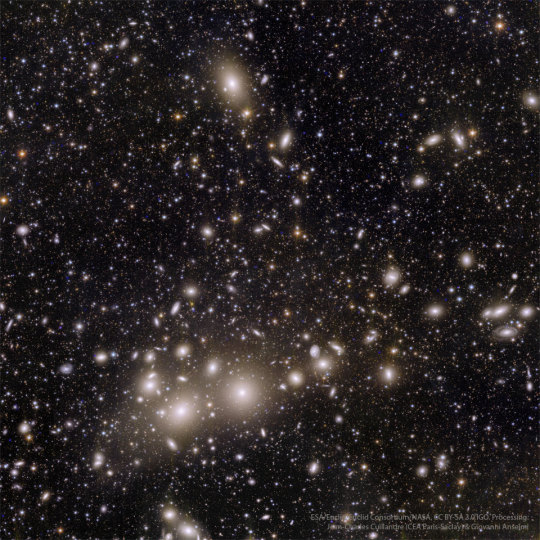
2023 November 8
Perseus Galaxy Cluster from Euclid
Image Credit & License: ESA, Euclid, Euclid Consortium, NASA; Processing: Jean-Charles Cuillandre (CEA Paris-Saclay) & Giovanni Anselmi; Text: Jean-Charles Cuillandre
Explanation: There's a new space telescope in the sky: Euclid. Equipped with two large panoramic cameras, Euclid captures light from the visible to the near-infrared. It took five hours of observing for Euclid's 1.2-meter diameter primary mirror to capture, through its sharp optics, the 1000+ galaxies in the Perseus cluster, which lies 250 million light years away. More than 100,000 galaxies are visible in the background, some as far away as 10 billion light years. The revolutionary nature of Euclid lies in the combination of its wide field of view (twice the area of the full moon), its high angular resolution (thanks to its 620 Megapixel camera), and its infrared vision, which captures both images and spectra. Euclid's initial surveys, covering a third of the sky and recording over 2 billion galaxies, will enable a study of how dark matter and dark energy have shaped our universe.
∞ Source: apod.nasa.gov/apod/ap231108.html
156 notes
·
View notes
Photo

Blue Marble Earth : Welcome to planet Earth, the third planet from a star named the Sun. The Earth is shaped like a sphere and composed mostly of rock. Over 70 percent of the Earth's surface is water. The planet has a relatively thin atmosphere composed mostly of nitrogen and oxygen. The featured picture of Earth, dubbed The Blue Marble, was taken from Apollo 17 in 1972 and features Africa and Antarctica. It is thought to be one of the most widely distributed photographs of any kind. Earth has a single large Moon that is about 1/4 of its diameter and, from the planet's surface, is seen to have almost exactly the same angular size as the Sun. With its abundance of liquid water, Earth supports a large variety of life forms, including potentially intelligent species such as dolphins and humans. Please enjoy your stay on planet Earth. via NASA
590 notes
·
View notes
Note
Regarding your post about solar eclipses on other planets - I know other planets get solar eclipses, too, but do any other planets besides earth get total solar eclipses?
Yep! I mean, that's why I worded that post specifically that way, and included links to the wikipedia articles about solar eclipses on the gas giant planets in our solar system.
So, a total solar eclipse happens on earth because the angular size of the moon as seen from the surface of the earth is (usually) larger than the angular size of the sun, right? (We see an annular eclipse when the moon's angular size is a little smaller than the sun's, depending on the relative distances of each since orbits are elliptical and those aren't constant.)
Jupiter, Saturn, Uranus and Neptune are all quite a bit farther from the sun, so the angular size of the sun is much smaller, and have fairly large moons. All of Jupiter's galilean moons are large enough and close enough to the planet that they're large enough to fully occult (cover) the sun and therefore produce total eclipses.
Similarly on Saturn:
Seven of Saturn's satellites – Janus, Mimas, Enceladus, Tethys, Rhea, Dione and Titan – are large enough and near enough to eclipse or occult the Sun, or in other words to cast an umbra on Saturn.
At this distance, the sun covers only about 3 arcminutes in the sky of Saturn. In comparison, the seven major moons of Saturn have angular diameters of 5–10' (Mimas), 5–9' (Enceladus), 10–15' (Tethys), 10–12' (Dione), 8–11' (Rhea), 14–15' (Titan), and 1–2' (Iapetus). Iapetus is Saturn's third largest moon, but is too far away to completely eclipse the Sun. Janus, a very close moon to Saturn, has an angular diameter of about 7', meaning that it can fully cover the Sun.
and Uranus:
Twelve satellites of Uranus—Cressida, Desdemona, Juliet, Portia, Rosalind, Belinda, Puck, Miranda, Ariel, Umbriel, Titania and Oberon—are large enough and near enough to eclipse the Sun.
and Neptune:
All of Neptune's inner moons and Triton can eclipse the Sun as seen from Neptune.
All other satellites of Neptune are too small and/or too distant to produce an umbra.
From this distance, the Sun's angular diameter is reduced to one and a quarter arcminutes across. Here are the angular diameters of the moons that are large enough to fully eclipse the Sun: Naiad, 7–13'; Thalassa, 8–14'; Despina, 14–22'; Galatea, 13–18'; Larissa, 10–14'; Proteus, 13–16'; Triton, 26–28'.
and also Pluto, really:
Charon has an angular diameter of 4 degrees of arc as seen from the surface of Pluto; the Sun appears much smaller, only 39 to 65 arcseconds. By comparison, the Moon as viewed from Earth has an angular diameter of only 31 minutes of arc, or just over half a degree of arc. Therefore, Charon would appear to have eight times the diameter, or 25 times the area of the Moon; this is due to Charon's proximity to Pluto rather than size, as despite having just over one-third of a Lunar radius, Earth's Moon is 20 times more distant from Earth's surface as Charon is from Pluto's. This proximity further ensures that a large proportion of Pluto's surface can experience an eclipse. Because Pluto always presents the same face towards Charon due to tidal locking, only the Charon-facing hemisphere experiences solar eclipses by Charon.
So all of these planets (modulo the lack of surfaces/living beings, but like, that's also pretty special to Earth completely separately from eclipses) experience the nighttime-like darkness caused by the umbra (shadow) of the eclipse (occultation).
Now, as a few people have pointed out in the notes, the ring of fire deal IS pretty special, which happens because the angular size of the moon and sun are often SO similar. (Maybe Iapetus is similar enough with the solar angular size sometimes depending where Saturn is in its orbit, but at a few arcminutes instead of half a degree you can imagine the effect being somewhat less amazing. Then again, I bet solar occultations by Saturn's rings are pretty amazing, so I'm not going to hold that against the planet.)
In no way do I think this makes total solar eclipses less awesome, or think that the excitement is misplaced. It's a pretty amazing special event! It's also one that won't even exist for the earth forever, since the moon moves a few centimeters away from us each year. But as an astronomer I think it's cool that there are eclipses (and occultations and transits of the sun by moons with smaller angular sizes!) on other planets too! Though, the post I made was mostly a kneejerk eyeroll complaint about a silly factual error that might just be because the OP of the post I was annoyed by was thinking about some other facet of our solar eclipses as being unique than how it was worded. Since we can't go to any other planet to watch eclipses (that would add a whole extra layer to astrotourism), our eclipses on earth are pretty special. If you ever have the opportunity to see one, I wholly recommend going! It's really amazing.
In conclusion: here's an Io solar eclipse on Jupiter taken by the Hubble Space telescope:

[Image in black and white shows Jupiter's volcanic moon Io passing above the turbulent clouds of the giant planet, on July 24, 1996. There's a large black spot on Jupiter which is Io's shadow. The smallest details visible on Io and Jupiter are about 100 miles across (about 160 kilometres). Bright patches visible on Io are regions of sulfur dioxide frost. Io is roughly the size of Earth's moon, but 2000 times farther away.]
And here's the April 8th eclipse of the sun by the moon on Earth as seen by the GOES satellite:

[A gif of the earth showing the GOES EAST view of North and South America on April 8th over the course of the total solar eclipse. A shadow of the moon passes from the left to the upper right side of the view of the earth.]
#replying to asks#anonymous#astronomy#solar eclipse#aj is a skyentist#i am not a planetary scientist but angular size is a good thing to understand!#i have participated in some of the lunar laser ranging though#for figuring out exactly how far away the moon is and how much it's moving around#i made the goes gif but mostly just saving it from the site and resizing it lmao
41 notes
·
View notes
Text

Agoralogoling, the Graffiti Borderling
Elusive and territorial, the Agoralogolings are seldom seen by many but their presence can be felt, as if their graffiti are silently watching you. They resemble the abstract calligraphic spray paint art, and their odor matches their visage. No Agoralogoling are the same, as they can appear either with sharp, geographical shapes or round blobby ones. They are always monstrous, resembling creatures such as sharks, serpents, and dinosaurs. Their Ichor oozes out from openings on their bodies, which are needed for the Borderling to live. Although capable of running and swimming, they are mostly seen levitating 3ft to 7ft off the ground.
Avoid any close contact with the Agoralogolings! Highly predatorial, they will persue humans or any large animal in their line of sight. Flat surfaces are their ideal way of travel, swimming fast as a flat form until their close enough to their prey to lunge as a 3-dimensional being. Other methods include ambushing prior to standing still, motionless. Once caught, the creature vomits their Ichor, covering the victim's body. The transformation process is painful, mutating the Witnesses' bodies into vibrantly-colored painted figures. Agoralogolings born from this formation will have humanoid shapes merged with their own.
The Agoralogolings spend all of their time creating graffiti on any flat surface they could find. Graffiti made by the Borderlings are living creatures. Temporary, they disappear within a day or two after creation. 1/25 of these creatures develop into new Agoralogolings and began excreting paint on their own. Victims' bodies are grauantee to undergo this special type of mutation.
The Agoralogolings can manifest around buildings with very little human activity. They appear in places untouched by civilization in a minimum of a month and a maximum of 3 years. Preferred locations include abandoned buildings, underpasses, and subway tunnels.
Signs of Agoralogoling activity are single splatters of paint which slowly grows overnight, when nobody's watching.
At the start of generation, beads of paint start to sweat out from the walls. A single Agoralogoling explodes outwards from the opening once it expands to at least 6 feet in diameter. Angular structures form around the portal before it collapses onto itself. Two rarely emerge from the same hole, which breaks apart and goes in separate directions.
Agoralogolings can corrupt any paint-related Borderling within a 20ft radius. After one minute of exposure, they begin to behave erratically, using their own Ichor the same way as the Agoralogolings. Their impulsive tendencies make them vandalize their own artwork, graffiti painted over everything. This is a temporary change in behavior, as they revert back to their original behaviors once after the Agoralogolings vanish.

#isb#borderlings#i see Borderlings#my art#art#artists on tumblr#monster#shark#graffiti#dinosaur#creature#blue#teeth#surreal#graffittiart
16 notes
·
View notes
Photo
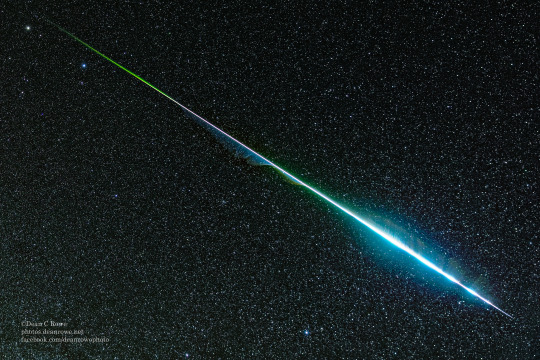
A Rainbow Geminid Meteor
Image Credit & Copyright: Dean Rowe
Meteors can be colorful. While the human eye usually cannot discern many colors, cameras often can. Pictured is a Geminid captured by camera during last week's meteor shower that was not only impressively bright, but colorful. The radiant grit cast off by asteroid 3200 Phaethon blazed a path across Earth's atmosphere longer than 60 times the angular diameter of the Moon. Colors in meteors usually originate from ionized elements released as the meteor disintegrates, with blue-green typically originating from magnesium, calcium radiating violet, and nickel glowing green. Red, however, typically originates from energized nitrogen and oxygen in the Earth's atmosphere. This bright meteoric fireball was gone in a flash -- less than a second -- but it left a wind-blown ionization trail that remained visible for several minutes.
The Geminid meteor shower is easily one of the best and most anticipated meteor showers in of the year, and it peaks tonight, 13 December. To be precise, the 2022 Geminid meteor shower will peak around 13:00 UTC on 14 December, making the night of 13/14 December the best opportunity for seeing a Geminid meteor.
122 notes
·
View notes
Text
Mod 3: Gymnosperms
Pinus Needle T.S.
It is circular in outline in P. monophylla, semicircular in P. sylvestris and triangular in P. longifolia, P. roxburghii, etc.
Outermost layer is epidermis, which consists of thick-walled cells. It is covered by a very strong cuticle.
Many sunken stomata are present on the epidermis.
Each stomata opens internally into a substomatal cavity and externally into a respiratory cavity or vestibule.
Below the epidermis are present a few layers of thick-walled sclerenchymatous hypodermis. It is well developed at ridges
In between the hypodermis and endodermis is present the mesophyll tissue.
Cells of the mesophyll are polygonal and filled with chloroplasts. Many peg-like infoldings of cellulose also arise from the inner side of the wall of mesophyll cells.
Few resin canals are present in the mesophyll, adjoining the hypodermis. Their number is variable but generally they are two in number.
Endodermis is single-layered with barrel-shaped cells and clear casparian strips.
Pericycle is multilayered and consists of mainly parenchymatous cells and some sclerenchymatous cells forming T-shaped girder, which separates two vascular bundles. Transfusion tissue consists of tracheidial cells.
Two conjoint and collateral vascular bundles are present in the center. These are closed but cambium may also be present in the sections passing through the base of the needle.
Xylem lies towards the angular side and the phloem towards the convex side of the needle.
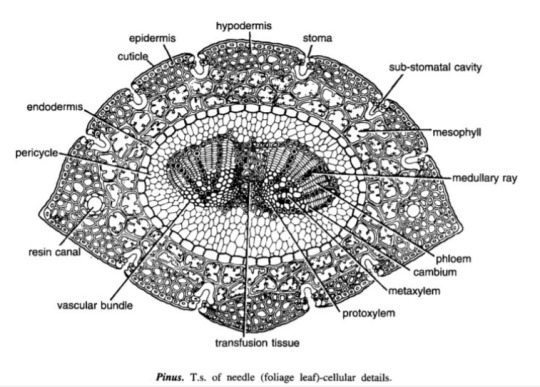
Idk where to find xeric nature info
Williamsoniaceae
Occurrence of Williamsonia
Williamsonia belongs to family Williamsoniaceae of Bennettiales.
It has been reported from Upper Triassic period but was more abundant in Jurassic.
This was earlier discovered under the name Zamia gigas by Willamson in 1870 but has now been named as Williamsonia.
Professor Birbal Sanhi (1932) described W. sewardiana from Rajmahal Hills of Bihar (India).
External Features of Williamsonia
Williamsonia resembled Cycas in appearance, but its best-knows species is W. sewardiana. The plant had an upright, branched, and stout stem covered by persistent leaf bases.
A terminal crown of pinnately compound leaves was present. For the stem genus Bucklandia, Sharma (1991) opined that features of leaf bases such as their shape, size and arrangement pattern are of taxonomic significance.
He observed that leaves in Williamsoniaceae show syndetocheilic stomata with rachis possessing collateral endarch vascular bundles.

Reproduction in Williamsonia
The fructifications of Williamsonia were large and attained a diameter of about 12 cm.
They were borne on a peduncle.
Many spirally arranged bracts were present around the base of the floral axis.
In W. gigas the cones were present among the crown of leaf bases while in W. sewardinia they were present on the short lateral branches.
Williamsonia plants were unisexual.
Female Flower
The female 'cones' of W. gigas and W. sewardiana have been investigated in detail. Instead of 'strobili' or 'cones', Sporne (1965) proposed to use the term 'flower'.
The conical receptacle was surrounded by many perianth-like bracts. The ovules were stalked.
The apex of the receptacle was naked and sterile. The nucellus was surrounded by a single vascularize integument, which was fused with the nucellus. The nucellus had a well-marked beak and a pollen chamber. In young ovules the micropylar canal was long and narrow.
In mature ovules, the canal widened because of the formation of nucellar plug and disappearance of interlocking cells. In the apical part of the endosperm, Sharma (1979) observed 2 or more archegonia.

Male Flower
Male flowers consisted of a whorl of microsporophyll's which were united to form a more or less cuplike structure. In majority of the investigates species the sporophylls were un-branched but in some species they were also pinnately branched.
Sitholey and Bose discovered W. santalensis from Upper Gondwana, and observed that microsporophyll's in the species were bifid.
One of the branches of microsporophyll was fertile while the other was sterile. The fertile part has finger-like structures called synangia. Each synangium had two rows of chambers enclosing microsporangia.
The fertile branch of the bifid sporophyll possessed many purse-like capsules, in each of which there were present many monocolpate pollen grains.

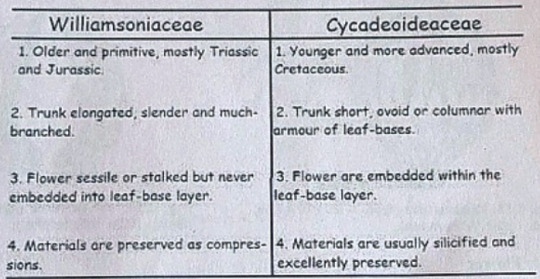
Cycadeoideaceae
Classification:
Division - Cycadeoidophyta
Order - Cycadeoideales
Family - Cycadeoideaceae
Genus - Cycadeoidea
Introduction:
Cycadeoidea is the only genus of family Cycadeoidaceae, represented by thirty species. They are entirely extinct and resemble cycads in the outward stumpy appearance of trunk and an apical crown of pinnate compound leaves. This fossil group of plants flourished during the Triassic to Cretaceous periods of the Mesozoic era. They are reported from various places in the world, in India the Cycadeoidales are found in Rajmahal Hills in Bihar. The petrified trunks of C. entrusca are the oldest fossil ever collected by man.
External Features:
The genus Cycadeoidea had a short, branched, or unbranched spherical, conical, or irregular trunk. The diameter of the trunk is 50cm and the highest rarely reached a meter except in C. jenneyana, it attended the height of several meters. These trunks are covered by rhomboidal leaf bases having multicellular hairs in between. Crown of 10ft long pinnate compound leaves are present at the top.
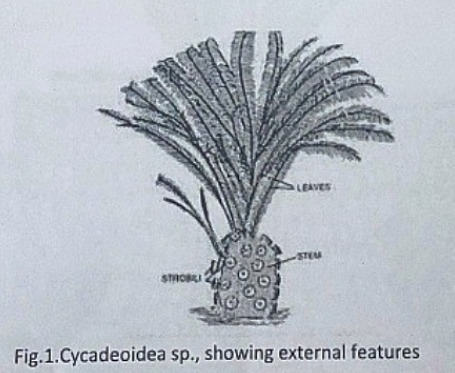
Anatomy of Stem:
The transverse section of the stem shows roughly a circular outline. The epidermis is not very distinct due to the presence of heavy armor of leaf bases. The cortex is parenchymatous and traversed by mucilage canals and numerous leaf traces. The primary vascular structure consists of a ring of endarch, collateral, conjoint, and open vascular bundles encircling the pith. Pith is wide and parenchymatous. A ray-like extension passes between the vascular bundles that make their appearance discrete.
There is a cambium ring with a thin zone of secondary wood. The secondary wood encircles the primary xylem and consists of tracheids with scalariform and bordered pits. The secondary medullary rays traverse the secondary xylem and secondary phloem.
The C-shaped leaf traces arise singly from the primary vascular strand and entering the cortex divided into several masarch strands and enters straight into the leaf.
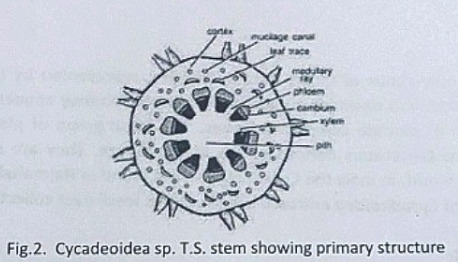
Anatomy of Leaf:
The pinnules show xerophilous structure. The upper and lower epidermis is heavily cutinized and thick walled. The mesophyll cells are distinguished into palisade and spongy parenchyma. The vascular bundles are mesarch and surrounded by bundle sheath.
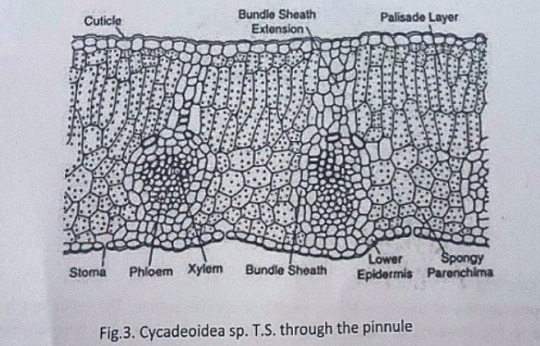
Reproduction:
The reproductive structure is represented by flowers. In most of the species, the flowers are bisexual and arise in the axil of each leaf.
Structure of Flower:
The flowers are bisporangiate, stalked, and partially sunken in the leaf base armor. Rach such mature flower is 5-10cm in diameter and 10cm long. From the base of such flowers about 100 to 150 hairy bracts arise in close spiral little below the apex. These bracts formed a perianth like structure and protect the megasporangiate and microsporangiate parts of a flower. The microsporophyll or androecium forms a whorl united at the base into a sheath. The megasporophyll or gynaecium consists of numerous stalked ovules born around a central receptacle. Between the ovules, interseminal scales with expanded tips are present. These expanded tips fused to form a continuous surface with pores, through which the micropyle of ovules extended. The vascular supply of flowers consists of many branches from leaf traces.
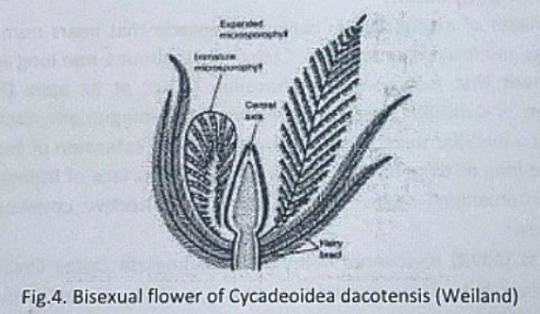
Microsporophyll or Androecium:
The microsporophyll is 10-12cm long, consists of a central rachis bearing numerous pinnae. The pinnae bear two rows of bean-shaped shortly stalked pollen capsules or synangia. These pollen capsules are born on the trabeculae within the fertile region of microsporophyll. A line of dehiscence is also visible at the base of each microsporophyll. This suggest that the entire microsporophyll might have been shed as a unit. The pollen capsule or synangia measures about 3.5x2.5mm and its wall is several layers thick, the outer layer made up of palisade like cells, and the inner layer is made up of thin-walled cells followed by a tapetum. The tapetum was not demarcated. A ring of microsporangia arranged around the periphery of each synangium. The microsporangia dehisce longitudinally and release the microspores into the synangial cavity. At maturity, the synangia liberate these microspores outside by an apical opening that splits into two valves. The liberated microspores or pollens are oval, measures up to 68µ that represents the male gametophytes. Pollen grains of Cycadeoidea are multicellular.
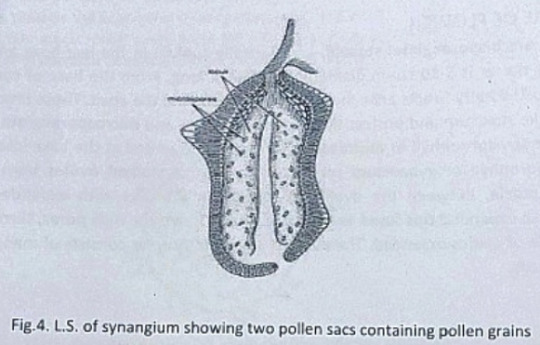
Megasporophyll or Gynoecium
The gynoecium consists of a spherical or conical receptacle that bears numerous stalked orthotropous ovules and interseminal scales. Each ovule is about 1mm long and consists of the single integument that fused with the nucellus except at its apex.
According to Lignier, in C. morieri, nucellus is free from the integument. Each ovule has a pollen chamber and a nucellar beak. This nucellar beak is the extension of the integument. The ovules also have long micropyle, extended from the flat surface of interseminal scales. The fused tips of interseminal scales form an external protective covering or pericarp surrounding the seeds.
Crepet and Delevoryas discovered many of bisporangiate cones from the Cretaceous of black hills. They studied the structure of these ovules in detail. These ovules are urn-shaped and resemble with the ovules of C. wellsii. According to them the micropyle of these ovules are funnel-shaped due to the constriction below the flaring. The inner wall of the micropyle is lined with large cells, considered to be epidermal cells. The integument has three distinct layers. The outer fleshy layer of radially elongated cells, the middle stony layer made up of thick-walled cells, and the inner layer is fleshy.
The young nucellus is made up of thin-walled cells. The cells at the micropylar end are much elongated (80µ long) in comparison to the cells of the chalazal end. The cell at the nucellar tip is pointed up tp whereas cells on either side are bend outward to give the nucellus a distinct shape.
Crepet and Delevoryas reported a linear tetrad or row of three cells in the center of the nucellus.
The seeds are somewhat elongated or oval and possessed two cotyledons.

#exam season#send help#biology#notes#science#botany#gymnosperms#pines#pine trees#pine needles#plants#plant science#plant biology#nature#long post
8 notes
·
View notes
Text

Locked to the strip. The NW105 5-Lug Beadlock wheel is very similar to our original NW105 5-Lug one piece forged monoblock wheel with one big exception: It has been re-engineered to include a special bolt-on outboard beadlock ring that, like the wheel itself, is also precision-machined from forged 6061-T6 aluminum. This forged aluminum ring holds the tire securely in place, to limit unwanted tire slip against the wheel, and to keep the tire from unseating, at very high speeds. The forged beadlock ring is secured to the wheel with a series of 21 standard lightweight titanium bolts. The Forgeline forged monoblock NW105 5-Lug Beadlock features a split 7-spoke design with tapered angular spokes and pronounced chamfered edges that creates a high-tech appearance on par with its advanced engineering technology and standard-setting performance capability. It is is available to order immediately in 17-inch, 18-inch, and 19-inch diameters in a range of widths and custom offsets & fitments. And just like any Forgeline wheel, the NW105 5-Lug Beadlock is available with fully customizable finish options. Learn more (including sizes and pricing) at: https://forgeline.com/wheel/nw105-5-lug-beadlock
🇺🇸🇺🇸🇺🇸
#forgeline#forgelinewheels#forgedwheels#customwheels#forgedmonoblock#NW1055LugBeadlock#ForgelineNW1055LugBeadlock#beadlock#dragracing#notjustanotherprettywheel#doyourhomework#madeinUSA#PRIShow#PRI2023
8 notes
·
View notes
Text
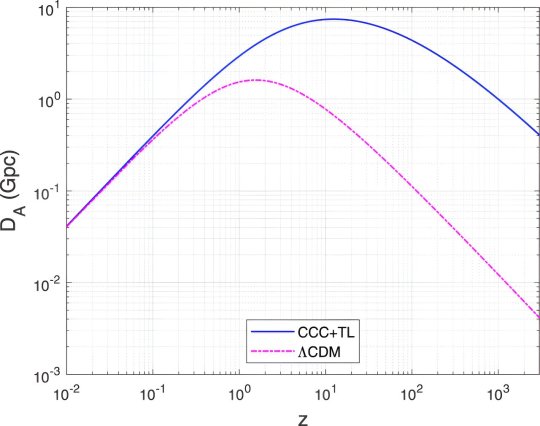
New research suggests that our universe has no dark matter
The current theoretical model for the composition of the universe is that it's made of normal matter, dark energy and dark matter. A new University of Ottawa study challenges this.
A study, published today in The Astrophysical Journal, challenges the current model of the universe by showing that, in fact, it has no room for dark matter.
In cosmology, the term "dark matter" describes all that appears not to interact with light or the electromagnetic field, or that can only be explained through gravitational force. We can't see it, nor do we know what it's made of, but it helps us understand how galaxies, planets and stars behave.
Rajendra Gupta, a physics professor at the Faculty of Science, used a combination of the covarying coupling constants (CCC) and "tired light" (TL) theories (the CCC+TL model) to reach this conclusion.
This model combines two ideas—about how the forces of nature decrease over cosmic time and about light losing energy when it travels a long distance. It's been tested and has been shown to match up with several observations, such as about how galaxies are spread out and how light from the early universe has evolved.
This discovery challenges the prevailing understanding of the universe, which suggests that roughly 27% of it is composed of dark matter and less than 5% of ordinary matter, remaining being the dark energy.
Challenging the need for dark matter in the universe
"The study's findings confirm that our previous work ("JWST early universe observations and ΛCDM cosmology") about the age of the universe being 26.7 billion years has allowed us to discover that the universe does not require dark matter to exist," explains Gupta.
"In standard cosmology, the accelerated expansion of the universe is said to be caused by dark energy but is in fact due to the weakening forces of nature as it expands, not due to dark energy."
"Redshifts" refer to when light is shifted toward the red part of the spectrum. The researcher analyzed data from recent papers on the distribution of galaxies at low redshifts and the angular size of the sound horizon in the literature at high redshift.
"There are several papers that question the existence of dark matter, but mine is the first one, to my knowledge, that eliminates its cosmological existence while being consistent with key cosmological observations that we have had time to confirm," says Gupta.
By challenging the need for dark matter in the universe and providing evidence for a new cosmological model, this study opens up new avenues for exploring the fundamental properties of the universe.
IMAGE.....Angular diameter distance as a function of redshift in CCC+TL and ΛCDM models. Credit: The Astrophysical Journal (2024). DOI: 10.3847/1538-4357/ad1bc6
3 notes
·
View notes
Note
Actually how big would my two moons appear on Tlaloc (The name of the planet) appear in the sky? I would use SE or US but I don't think my new laptop could handle SE and I can't buy US due to me not having online money currently. I know both of Mars moons can hypothetically be seen in the sky so I was wondering what much bigger objects would look like. I really wish I had a reference photo or something.
i dont think you sent information about their distances in your last ask.
remember, use the small-angle cosine approximation which is:
angular diameter in radians = diameter of object / distance to object (in the same units)
the answer will be a really small fraction of a radian. Convert that to a slightly larger fraction of a degree by multiplying by 180°/π.
The Moon is half a degree, so you can compare your answers with the Moon to get a rough idea of what they'd look like.
For example, Phobos is 26km wide and 5979km away from Mars' surface.
26km/5979km = 0.00434855327 radians
0.00434855327 * (180°/π) = 0.249153749°
so about 0.25°, or half the apparent diameter of the Moon as seen from the Earth.
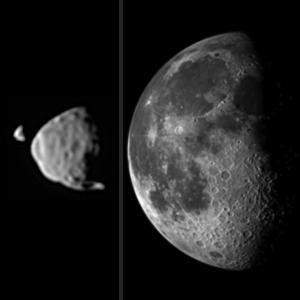
Here's Deimos and Phobos as seen from Mars (not hypothetically--this is an actual photo taken by Curiosity iirc) versus the Moon as seen from Earth, to scale. Except that you'd never see the Moon that big in the sky, without a telescope.

Hold your head back from the screen and hold your pinkie out at arm's length so that your pinkie nail can cover the moon entirely. That's how small the Moon really is in the sky. Note that Phobos is still visible as a disk, but Deimos is reduced to a dot. In reality it would still be a very bright dot, like, probably much brighter than Venus. But not resolvable as a disk without incredible eyesight or binoculars/small telescopes.
You can make a similar size comparison on a piece of graph paper (or on the computer). Maybe set one grid unit equal to 1/10th of a degree, then draw a 5-unit diameter circle for the Moon, then use your answer to the angular size calculation to figure out the diameters of the other planets.
Also, consider using Celestia if you can't use Universe Sandbox^2 or Space Engine. Celestia won't procedurally generate any surfaces for you, but it can still show you what your system should look like in 3D if you learn to make configuration text file mods for it.
There are probably open source gravitational simulators that are free, but they'll surely be harder to pick up and use.
5 notes
·
View notes
Text
🌺 Merch Reveal: Round Button 🌺
This beautiful merch designed by @spacupanda will be available exclusively as a part of our 2 highest tiers! The button is 2.25 inches (5.8 cm) in diameter and is a must-have addition to any Kairi collection.
Follow us @kairizine to see more merch reveals leading up to the Destiny's Embrace March 28th preorders!
[Video description:
The video is framed by clusters of flowers: pink hibiscus, pale gold dandelions and purple morning glories. Imposed on top of them is an angular, faceted frame with a Destiny’s Embrace zine-branded logo in the top right corner.
Inside the frame is a mock-up of a circle pin with Kairi in her KH attire popping out from a field of purple anemones. Her surprised expression and slightly mussed up red hair are highlighted by the deep blue of the night-time sky and darker cast of the entire scene. In the sky are lights like the aurora borealis. The light is simulated to refract through the lens of the viewer, shown through the use of flecks of rainbows.
To the right of the artwork, we see a handwritten title reading Button, and below that, bulletpointed with flower petals, in a clean, modern san-serif font: Round Button, 2.25 Inches (58mm), Glossy Finish, Designed by Sparkie. Beneath that, in bold, it reads, preorders open March 28.
End Description.]
#kairi#kingdom hearts iii#kingdom hearts iii re:mind#kh3#kh melody of memory#anemones#button#merch#merch reveal#sparkie
12 notes
·
View notes
Text
Spectral Shadows: Earth as a Haunted Planet and Humanity's Ethereal Legacy
Cratering in the Solar System
Have you ever looked up at the night sky and been amazed by the craters in the face of the moon, and wondered about the stories those craters could tell? Or if those stories about those craters, where ever connected to us? These are not only lunar features; they are found all over our solar system, scarring planets, moons and asteroids alike. They act as cosmic diaries, chronicling cataclysmic events that have shaped these celestial bodies. Each crater is a record of violent crashes and ongoing processes that continue to sculpt our neighborhood. This violent past has led some to call Earth, and humanity, haunted, marking us as the victims of an untold number of blows. According to Wiechert et al. (2001) the Eart and the Moon are shockingly similar, oxygen isotypes, which indicates that the Moon was once part of Earth, and this evidence supports what is called the collision and coalescence process, which describes a gigantic impact hypothesis long age, billions of years ago, between Eart and Mars. Canup and Aphaug’s (2001) computer simulations demonstrated how Mars sized impactor could have lead to the development of the moon, too. Through angular momentum and orbital dynamics, Cuk and Stewart (2012) explained that the present angular momentum and orbital dynamics of the Moon, likely became an outcome of an enormous impact, as well. There was evidence of a lunar magma ocean, according to Snyder, Taylor, and Neal (1992), that supported insights into a past lunar magma ocean, which further provides evidence of an impact hypothesis. As well as, Earth’s tilt, and lengths of day, post-impact, speaking that is, was founded to be influenced by the same impact that formed the Moon, too (Kokubo, Laminami, and Ida 2000).
In this sense we could say that the earth carries with it its ancient histories like a haunted house bears its ghosts. And it’s true: in becoming bipedal monkeys with binocular vision we have stepped into nature’s antechamber of secrets. Our evolutionary path has not only fitted us to our environment but given us enough smarts to possibly deflect or escape future cosmic slaps. How might this affect how we see ourselves in relation to everything else? Are we just survivors on a 'haunted' planet or stewards with control over our own fate? As we explore more about what causes craters within our solar system and their consequences, these questions become increasingly relevant. Could understanding our 'haunted' past help us safeguard our future?
Planetary Science
"Planetary Sciences" by Imke de Pater and Jack J. Lissauer is a book which delves deeply into how craters form mechanically as well as what implications this holds for knowledge about other planetary bodies. The authors discuss how meteorites ,asteroids and comets impact structural development of planets regarding atmosphere . A scar may be more than just skin deep; indeed it can offer us insight into what happened before those involved were even born such is their potential as time capsules. According to the book, craters can speak volumes about both the stuff that hit them and what they hit. They also indicate how often such interplanetary violence occurs through their numbers, sizes (diameters) and shapes, which may in turn hint at worlds’ ages. Based on these features scientists can infer surface age as well as processes that shaped it through time. The text further looks into central peaks, rings and ejecta blankets being some of the complex structures formed by kinetic energy transformation during impact events where rocks get shocked into new configurations. The aim is to help us understand more about our own planet but this knowledge has implications for understanding other worlds too. “The variety of impact craters across our solar system mirrors different kinds of violent planetary histories,” says de Pater.” These findings highlight why we need to keep watching out for future cosmic bombardments as well as defend against them now”. Ultimately then, this book offers an explanation on how most of what we see on planets like Mars or moons such as Europa came to be there, through violent events like those described within its pages.
Human Evolutionary Traits
"Human Evolutionary Traits" by Robert Boyd and Joan B. Silk describes how the concept of “adaptive landscapes” can be used to understand the evolution of human traits. The authors explain that an adaptive landscape is a metaphorical representation of how different genetic variants (or phenotypes) are favored or disfavored in a particular environment. This metaphorical landscape consists of hills and valleys, with each peak representing a different genetic variant that is well-suited to its environment. Genetic drift and natural selection act as forces that push populations up these hills towards greater fitness. In this context, fitness refers to an organism’s ability to survive and reproduce in its environment.
The book then goes on to discuss various human traits in terms of their adaptive landscapes. For example, the authors explain that bipedalism has allowed our species to occupy and exploit a wide range of ecological niches. They argue that walking on two legs freed up our hands for tool use, which in turn led to increased brain size and cognitive abilities. Similarly, they suggest that our unique vocal apparatus evolved under the pressure of social competition within large groups.
Boyd and Silk also explore how cultural evolution interacts with biological evolution in shaping human traits. They assert that culture acts as an additional adaptive landscape, providing new opportunities for adaptation beyond what is possible through genetic change alone. Cultural innovations can spread rapidly through populations via social learning or imitation, allowing groups to adapt more quickly to changing environments.
Furthermore, the authors propose that gene-culture coevolution may have played a significant role in human evolution. Gene-culture coevolution occurs when genes influence cultural behaviors, which in turn affect selective pressures acting on those genes. For instance, lactose tolerance among certain populations may have coevolved with dairy farming practices.
Accordingly, Boyd and Silk contend that many features of human psychology can only be understood within this gene-culture framework. They argue that humans are biologically predisposed to acquire and transmit cultural knowledge, which has allowed our species to rapidly accumulate technological advancements over time. Moreover, they suggest that certain cognitive biases may have evolved because they were adaptive in ancestral environments characterized by cultural learning.
Finally, the book concludes by discussing the implications of these ideas for understanding human nature and the future of our species. Boyd and Silk acknowledge that genetic and cultural evolution are two distinct but interrelated processes. They caution against reductionism in both directions, recognizing that biological factors can influence cultural practices just as cultural practices can shape genetic variation.
In summary, “Human Evolutionary Traits” provides a comprehensive overview of how different forces have shaped the human species over time. It highlights the complex interplay between genes, culture, and environment in determining adaptive outcomes. The text also emphasizes the need for an interdisciplinary approach to studying human evolution, drawing on insights from biology, anthropology, psychology, and other disciplines. Ultimately, this book challenges readers to consider what it means to be human within the context of a constantly changing world.
In "The Descent of Man," Charles Darwin starts a conversation on the evolution of man that has been around for centuries by illustrating what distinguishes Homo sapiens from other species. He explores physical and mental attributes developed over thousands of years as well as their adaptability to different environments. One such adaptation is walking on two legs which he considers key to human survival and mobility. Also, large brains in humans are among the traits discussed by Darwin who connects them with advanced cognitive abilities like problem-solving skills or language use etcetera. These changes not only ensured our continued existence but also led us into creating complex societies with diverse technologies around us today. Therefore his work implies that people have always changed themselves to fit into new situations brought about by nature thus making life easier than it was before.
Technological Measures for Asteroid Deflection
The DART Mission is a major move forward in planetary defense technology according to NASA. It will test whether or not asteroids can be deflected from Earth’s orbit using kinetic impactors. The idea behind this method is that one or more spacecraft would be launched into space where they would collide with an asteroid at high speed so as to change its path away from earth. This mission focuses on binary asteroid systems because they provide an opportunity to examine how impacts affect smaller objects revolving around larger ones in space; thus helping verify if kinetic impactors can be used to deflect asteroids successfully or not. Advanced navigation techniques will be employed during planning stages while executing accurate strikes needs sophisticated equipment too since it involves precise calculations based on various factors such as gravity pull between bodies involved among others. Besides these defense strategies, valuable knowledge regarding composition and structure shall also be obtained through close examination of materials constituting such bodies during encounters initiated by NASA’s DART mission towards enhancing future deflection methods aimed at averting catastrophic events worldwide. Unveiling global tactics for safeguarding planet earth against potential devastating collisions forms part of objectives set by NASA for DART Mission which seeks to better understand impacts caused by fast moving objects like meteors.
The textbook “Planetary Sciences” (by Imke de Pater and Jack J. Lissauer) explains why most objects in the solar system exhibit a great deal of cratering. That many impacts took place over billions of years is evidenced by this. Indeed, the history of our solar system has been dynamic and occasionally violent. According to the authors, these collisions are not random but are caused by gravitational interactions between celestial bodies within their systems that can redirect them towards planets or moons. Every impact leaves behind a crater as well as information about both the impacted surface and the impactor itself at that time. Lack of atmosphere or weak atmosphere makes it easier for an object coming from space to hit such places because there is no atmospheric frictional force which would burn up most meteors before they reach ground level; hence more craters are found on bodies like this than anywhere else i.e., distribution, size frequency across various bodies helps us understand age and evolution of landscapes – heavily cratered surfaces imply oldness through lengthened exposure while less-cratered areas could be young with active geology erasing hits over time; also tells us something about what’s been happening elsewhere in space historically: e.g., resurfacing events throughout whole planets’ or past shifts in planetary orbits that might have altered their vulnerability to being struck by cosmic speedsters. So yes indeed, although they bear witness only to violent histories yet also show how worlds come into being and transform themselves.
Geologic processes and Earth’s dynamic systems
It cannot be supported by the current scientific knowledge that presumes a biological or planetary ability to see into the future. Prescient biology or planetary sensing as it is often called suggest that organisms or ecosystems may predict what will happen next in their environment and adapt accordingly. However, evolutionary biology and geosciences perceive changes as responses to present conditions. Organisms adjust themselves to suit their surroundings through natural selection which does not work with foresight but acts on genetic variations while responding to immediate demands placed upon them by prevailing circumstances of life. Likewise, physical forces and contemporary conditions cause geological changes such as mountain building or continental drifts rather than anticipatory ones; these are reactive processes too. Although poetic, therefore one must distinguish between metaphorical representations that can be seen in life responding with some sense of knowing what is coming ahead.
Evolutionary Biology & Natural Selection
Natural selection is a key concept in explaining how species change over time through adaptation to different environments. Mutations occur without any anticipation on where they will happen thus benefiting an organism in its struggle for survival within a particular habitat Natural selection then occurs when such traits become more common over many generations hence resulting into evolution of new species . As described by Charles Darwin this theory provides for mechanisms by which living things have come about over long periods so that those best suited survive while others fail This process only looks back at what worked before but does not know anything ahead.
Astrobiology
Astrobiology is a multidisciplinary field that investigates the origin, development, distribution and future of life within the universe. It integrates biology with chemistry, physics and planetary science. “An Introduction to Astrobiology” (2008), edited by Rothery, Gilmour and Sephton is a key text in higher education establishments as it covers all these areas relating to astrobiology in great depth. Similarly, Bennett and Shostak’s “Life in the Universe” (2016) focuses on the scientific methods used to search for extraterrestrial life whilst looking at life’s potential beyond Earth.
Astrobiology looks at what is required or needed for life to exist in terms of environments and conditions; this helps us find places where life might be found elsewhere (Bennett & Shostak 2016). On Earth we have examples which demonstrate how hardy living things can be so Rothery et al., discuss these earthly organisms as representing models that could apply on other planets too – therefore it would seem sensible to suppose that wherever there are diverse environments here there could also elsewhere.
Water is often seen as being essential for living systems’ development: this fact has not escaped attention within astrobiological studies either. The two books under review both say much about our need to start seeking out extra-terrestrial organisms close by checking for signs of liquid H2O somewhere within our solar system first (Bennett & Shostak 2016; Rothery et al., 2008). For example Mars still remains one good candidate because once upon a time there might have been or perhaps even still is some form of water activity happening beneath its surface; likewise Europa appears another strong contender due largely thanks mainly only but not exclusively just simply on account because evidence exists indicating past presence thereof suchlike etcetera so forth etc..
Astrobiology also involves investigating extremophiles – creatures which thrive under conditions that would kill most other life forms here on Earth. “An Introduction to Astrobiology” explains how studying these organisms can help us understand where we might find habitable environments elsewhere (Rothery et al., 2008). In addition, Bennett and Shostak state that they broaden the range of potential habitats for life beyond what is normally considered by astrobiologists since it may be possible for them to survive in extreme places suchlike etcetera so forth etcetera.
Another area covered by both texts is weird life – alternative biochemical possibilities of living systems which have different chemistries than any known forms found on our planet (Bennett & Shostak 2016; Rothery et al., 2008). For instance there could exist types of organisms that use solvents other than water such as methane or ammonia, which might occur within colder bodies like Titan according to Rothery et al..
Moreover, astrobiologists are interested in planetary atmospheres because detecting gases associated with life could indicate its presence. According to Rothery et al. this involves missions aiming at exoplanets where they will analyse atmospheric compositions in order look out for signs showing biological activity; also it would help us narrow down the list of worlds worth studying more intensively if we were able determine what type(s) etcetera so forth etceteras.
Ethical and philosophical issues surrounding the discovery of extraterrestrial life feature strongly within astrobiological thought too. For example, “Life in the Universe” contemplates how finding other living things somewhere else changes everything about what we know concerning uniqueness here on Earth as well as our place within this vast cosmos revealed through space exploration (Bennett & Shostak 2016). Similarly “An Introduction to Astrobiology” briefly mentions protocols plus ethical considerations linked with contaminating other planets during their subsequent investigation for signs indicating past or present existence thereof suchlike etcetera so forth etc..
To conclude, this study of astrobiology presented in these foundational texts does not only expand our knowledge about the possibilities of life in the entire universe but also deepen our understanding on earth. This research calls for multi-disciplinary approach in addressing some of the most fundamental questions regarding our existence and what life is made up of. McKay et al.’s (1996) celebrated work published in Science involved analysis of ALH84001 meteorite from Mars which showed signs fossilized micro-organisms thus exciting many researchers working within Astrobiology but it also sparked off a heated debate among them too because such findings could imply that there might have been life forms in ancient times on this planet too. They suggest that we need more studies like meteoritics for astrobiological purposes since their publication hinted at the likelihood of past life on Mars itself.
Advancements in Astrobiology
In Gillon et al.’s (2017) report published by Nature which describes discovery Trappist -1 system with several Earth sized planets orbiting around one star located within habitable zone; they indicate that these findings are important milestones towards finding habitable worlds beyond our solar system because now we have potential targets for looking further into space where other forms might exist or can exist if conditions were right somewhere else.
According to Siegler et al’s (2016) article given out through Nature Geoscience where they provide proof about presence water ice at lunar poles after studying Moon’s rotational axis; it is considered significant achievement of science as far as Astrobiology concerned since it implies that moon may possess necessary resources required by organisms living there or even those planning future explorations involving human beings.
Astrobiology also encompasses examining extremophiles found on earth which survive extreme conditions similar to those encountered elsewhere in universe. An example would be Rummel et al.’s (2014) paper published under Astrobiology title "Policy Considerations for Planetary Protection Based upon Extremophile Resistance to Space". This research has implications for contaminating other planets and this is because if there are such organisms which can live outside earth then it means they could unknowingly transport some microbes from one place onto another during their journey through space.
Continuous development of spectroscopic methods enables us detect biosignatures within exoplanet atmospheres. Seager et al.’s (2016) work published by Astrobiology explores potential gases indicating presence life thus giving astronomers basis to make observations on atmospheric composition when searching for extraterrestrial organisms in future.
"The Ethics of Space Exploration" is an edited volume by Vakoch and Dowd (2015); it discusses ethical implications about contacting extraterrestrial intelligence; besides talking societal impacts after finding ETI elsewhere, also shows various aspects surrounding astrobiology which makes discipline many faceted.
Other sections examine Earth’s impact craters as evidence of ancient collisions with comets and their effects on the planet’s geology and climate. The book also examines how these impacts could have caused major evolutionary steps and extinction events that would have altered the course of life on earth.
Moreover, this work takes into account both what is known about cometary science today from historical records and scientific study up until now; but it does not stop there. This books looks forward to future possibilities in astrobiology too – specifically, what might be discovered about finding life beyond our own world through researching comets? It mentions missions like Rosetta which are designed to get close enough to touch down on the nucleus of a comet and gather samples directly from its surface.
The authors editors propose that knowledge about comets is important not just as part of understanding where we come from here on earth or even for being ready should one hit us again someday – but also so that we may better know what else could be out there waiting for us among the stars. The final few chapters ask astronomers geologists chemists biologists space explorers of all types really work together using many different fields of study when looking at these icy bodies? What can this tell us about where they came from… how long ago… how did life begin?
All in all “Advances in Astrobiology and Biogeophysics: Comets and the Origin & Evolution of Life” covers all aspects necessary for understanding this area within astrobiological researches thus making them realize their importance in relationship with earthly existence itself while at same time allowing imagination fly towards other worlds too!
Geological Processes and Earth’s Dynamic Systems
The physical forces of heat, pressure and chemical interactions drive the earth’s geological processes including plate tectonics, erosion and volcanic activity. They reshape the environment but have no intention of working towards a particular outcome in future. In fact they are just natural reactions to present conditions on our planet. Also known as plate tectonics, erosion and volcanic activity among others; these same current physical forces such as heat, pressure or chemical interactions power geological processes that mold our world today. These activities can greatly affect and modify the surroundings but they are not deliberate adjustments made by one thing in expectation of another thing happening some time later somewhere else. Rather than being driven by anything else other than this dynamic balance within Earth systems; where should continents be located at? How does atmosphere composition change over time? What kinds of ecosystems do we find most frequently distributed? These are all questions which would arise from knowledge about ongoing events.
Ecological Relationships and Feedback Circuits
Interaction among species within ecosystems is one of the most important factors in determining its structure and function. For example, competition, predation, and symbiosis can all affect how many individuals of each species there are in different parts of an ecosystem. This was shown by Paine (1966), who found that when starfish were removed from the rocky intertidal zone as a keystone species, other organisms took over their role as top predator and caused widespread changes throughout the community. This work introduced the concept of keystone species which must be present for communities to maintain their organization. Ecological feedback loops are systems where output either amplifies or attenuates further output.
They are important for stabilizing ecosystems because they help to regulate them at some level of variability. Odum (1969) described feedback such as nutrient cycling and energy flow that cause ecosystems to become more complex over time through development or maturation processes. Conversely, these same mechanisms allow damaged ecological systems to rebound after disturbance events have ceased acting upon them any longer than necessary for recovery purposes alone when considered from this perspective alone!
Nevertheless while speaking about stability we shouldn't forget about local maxima, points characterized by strong positive feedbacks within particular system states which may prevent transitions between alternative stable equilibria even if required conditions exist elsewhere in phase space due mainly partially perhaps mostly primarily largely almost entirely maybe somewhat perhaps partly possibly not entirely but it should be also noted more much less only slightly hardly ever marginally significantly never. Equilibrium refers to balance among organisms living together indefinitely under given conditions without any change over time until something else happens instead of nothing happening at all times forever more or less always rather than never again!
Therefore knowledge about these relationships helps us manage conservation areas better and restore damaged habitats faster too by creating linkages between different types of living things with their surroundings at different scales across landscapes thereby showing us how everything is connected together like pieces in a puzzle or parts on a machine working hand-in-hand towards common goals where each part relies on another for its proper functioning until something else changes than what was there before it doesn't stop changing! The complexity of natural systems arises from interactions between organisms and their environments over time. These processes are often influenced by feedback loops which can produce counterintuitive results such as the maintenance of high levels of diversity following disturbance events. Ecological succession is driven by changes in community composition that occur as a result of species interactions mediated through environmental conditions. Feedbacks also operate across scales, an example being when one part of an ecosystem affects other parts either directly or indirectly through energy flows trophic cascades or displacing native species from their habitats during invasion processes which subsequently alters community structure elsewhere within invaded areas leading ultimately perhaps eventually potentially causing extinction-level events due mainly partially possibly partly primarily largely almost entirely not necessarily always often but not necessarily Frequently sometimes! Feedback loops provide insight into how ecosystems respond to perturbations and therefore may be used to predict tipping points in these systems under different management scenarios for example Those that include feedbacks among resources consumers producers predation competition mutualism symbiosis parasitism etcetera have been found useful decision-making tools because they allow us understand likely outcomes human activities on natural systems especially those related with changes use patterns land cover types within given landscapes thereby suggesting appropriate interventions. Ecosystem-based models help understand impacts various drivers at different spatial scales over longer temporal periods while enabling identification paths leading towards sustainable resource utilization However conservation action requires understanding wider contexts even if this means taking account more factors than currently considered thereby necessitating adoption an integrated approach towards management planning. Since, global environmental problems continue worsening ecological science plays increasingly important role in efforts aimed conserving our planet Earth’s unique biodiversity heritage Furthermore knowledge gained through studying feedbacks contributes broader recognition interdependencies among living organisms including homo sapiens besides promoting awareness about ecological goods services provided by ecosystems To this end scientists working ecology must therefore continue investigating these phenomena so as deepen appreciation for how they work under conditions characterizing global change.
Climate is a Feedbackloop
Climate feedbacks are processes that can enhance or diminish climate forcings like atmospheric CO2 changes. An example of a positive feedback mechanism is the ice-albedo feedback described by Curry et al. (1995) where melting ice reduces surface reflectivity and thus causes more solar absorption, heating the planet further. Such an effect becomes particularly significant in polar regions where local and global climates can be greatly modified through ice melts. On the other hand, negative feedback mechanisms such as increased cloud cover in response to warming play important roles too because they reflect more sunlight back into space thereby cooling down Earth’s temperature. Ramanathan et al.’s (1989) study showed how different types of clouds affect earth’s energy balance differently hence affecting climate change in various ways. Carbon dioxide concentration induced warming on Earth was also noted to be influenced by these processes which serve as critical elements for determining climate sensitivity to greenhouse gas emissions. According to this article, it is not possible to accurately model or predict anything about weather if one does not understand these things well enough; thus they should form part of any good model design since without them any forecast made would lack credibility. Climate models with built-in feedback loops are powerful tools that enable scientists understand what might happen under different conditions therefore used widely among researchers working on various fields related to environment protection including those involved in policy making processes globally. They help provide invaluable information required for coming up with measures aimed at mitigating effects brought about by changes occurring within our surroundings due to global warming. The reason why some areas warm faster than others during heating period could be explained through studying climate systems involving responses from different components interacting with each other over time scales characterized by gradual rise in temperature. On long term basis prediction patterns of climate may soon become impossible if we don’t continue monitoring these current trends closely enough. Therefore there is need for more research on this area which will result into new discoveries being made and added into existing models meant for predicting future climates globally. Consequently it makes hard to come up specific weather forecasts because many feedbacks are involved hence leading to complex outcomes. Reliability of climate system knowledge can only be improved if more attention is given towards understanding these aspects since they greatly contribute towards shaping our current understanding about how earth’s atmosphere works. Curry et al.’s (1995) work together with that of Ramanathan et al.(1989) have significantly helped us appreciate better the impact they have on global weather systems. The ongoing studies focus on finding out which of all known mechanisms could lead to most warming worldwide as part of efforts aimed at fighting against environmental pollution caused by human activities. Key insights gained by investigating such things should therefore be shared widely so as create public awareness concerning energy use patterns, infrastructural development processes and environmental conservation strategies.Dealing with climate change requires a multi-faceted approach where different stakeholders work together based on evidence from scientific investigations.
Chaos Theory in Meteorology
Meteorology entered the era of chaos theory when weather forecasting was completely overturned. This theory which reflects on the fact that systems are sensitive to initial conditions is best described by ‘the butterfly effect’. It was widely investigated by Edward Lorenz, a meteorologist who during 1960s came up with new ideas about relationship between small atmospheric changes and large-scale weather patterns. In his study of how tiny variations in initial conditions can produce greatly different forecasts, he found out that only slight errors at any point would eventually lead to entirely divergent predictions. The knowledge of this leads us to question whether or not it is possible to predict future states of weather with certainty based on current ones due to such an unstable environment as ours.
Nevertheless, these difficulties also brought about some positive outcomes regarding construction and application of weather models under chaotic circumstances. Currently ensembles of model runs with slightly different starting values are used for prediction making by meteorological services worldwide on daily basis. Such approaches recognize that long-term forecasting becomes impractical because there will always be uncertainty resulting from chaotic dynamics hence providing range estimates together with their probabilities which help users make informed decisions concerning what may happen next in terms of climate change impacts mitigation or adaptation measures implementation among other things. This method implies accepting chaos as being part and parcel of atmospheric science thus yielding better methods for more reliable forecasts.
But prediction accuracy is not the only area where chaos theory has made an impact; it has also influenced data collection integration as well as development of new technologies and methodologies towards this end. Higher resolution models coupled with increased computing power have greatly improved our ability to detect simulate chaotic behavior within the atmosphere which in turn enhances understanding dynamic processes governing weather variability so that we can forecast extreme events more accurately than before.
Moreover, what makes one still interested in studying atmospheric systems under turbulent conditions? By figuring out how certain types come into existence despite presence various others within similar settings scientists hope to gain insights into larger climatic interactions. The findings would have significant implications for improving such things as day-to-day weather predictions while at the same time advancing our knowledge on climate change and its impacts across global scales during this century.
The Gaia Hypothesis: Possible the Roots of Climate Change Reasoning too
In 1979, British scientist James Lovelock put forward the Gaia hypothesis which suggests that Earth is a single self-regulating system characterized by deep interconnections between living organisms and abiotic factors. According to this revolutionary concept, life actively modifies its surroundings in order to ensure favorable conditions for its own existence on the planet. The idea was expounded in his book entitled ‘Gaia: A New Look at Life on Earth’; since then it has greatly influenced various scientific fields including biology, ecology and earth sciences thereby opening up fresh avenues of enquiry with respect to understanding biosphere processes within our world.
At first, people did not believe in some of the claims made by the proponents of Gaia because they contradicted their view that organisms were only able to adapt passively rather than actively modify their environment. However over years evidence has been found which supports parts of Lovelock’s theories especially when it comes to atmospheric chemistry or biogeochemical cycles where scientists now recognize more clearly than before that these are shaped significantly by life itself.
In order to highlight the integrated nature of Earth’s systems in controlling climate and atmospheric conditions, Lovelock coined the term “Gaia”. The idea behind this thought is that all organisms interact with their non-living environment on this planet so as to create a complex self-sufficient system which works together synergistically towards establishing and sustaining life-friendly conditions here. Earth system science owes much to the Gaia Hypothesis which has led researchers to view Earth as one single system; they study interactions among various parts of this system.
The Gaia Hypothesis recognizes that living organisms keep environmental variables within ranges where life can thrive best. For instance, it regulates ocean salinity levels, global temperatures or atmospheric oxygen concentrations among others. Lovelock suggests that these controls happen unconsciously but emerge from Life’s encounters with its surroundings.
Despite being widely embraced within some quarters, critics have leveled several objections against this hypothesis too. Some argue that it simplifies ecological complexity excessively and anthropomorphizes nature while doing so. Nevertheless even those who oppose it strongly admit that the theory has fostered an integrative understanding of ecological systems like no other and promoted cross-disciplinary research among scientists.
It asks us as scientists to treat Earth as though she were one body – where feedbacks between organisms themselves and their environment are critical for maintaining conditions suitable for existence. Also, discussions about sustainability & environmental policy benefit from recognizing how delicate such balances must be if we want life-supporting conditions maintained on our planet throughout time.
Recently people started using Gaia Hypothesis when developing strategies for managing planets or advocating conservation methods which work with rather than against natural processes observable in Earth itself. Moreover it has stimulated debates over humanity’s roles within earth systems philosophically speaking.
As new demands arise due to environmental threats looming large; human need not only understand what is going on around them but also start taking responsibility for actions undertaken globally because everything affects everything else according to Gaia Hypothesis. Therefore it calls for worldwide holistic approach towards planetary health that recognizes unity between mankind and nature.
In recent years, the Gaia hypothesis has gained practical relevance in terms of planetary management and conservation strategies, which suggest methodologies consistent with earth’s own systems. It has also sparked philosophical inquiries regarding human beings’ place and duties within the wider context of our planet system.
The principles contained in Lovelock’s gaian theory continue to inspire different ways through which people can comprehend global environmental impacts resulting from human activities vis-à-vis sustainable development goals (SDGs). This invites a complete view of global health by encouraging cooperation between people living on earth today and their environment at large.
Gaia remains relevant because it inspires new thoughts about complexity of life forms interrelationships within ecosystems; this further informs ways of dealing with pollution control measures thus making it important for us as future generations to preserve earth.
Scientific Versus Conceptual Metaophors
Metaphors are valuable tools for science communication because they allow us to make complex ideas more accessible. Through metaphor, scientists can take abstract concepts and relate them to everyday experiences. This makes it easier for the general public to understand and appreciate science. Additionally, metaphors can help bridge the gap between scientific knowledge and personal understanding; they provide a common language that allows people from different backgrounds to connect with one another around shared ideas. For example, when explaining the concept of evolution, scientists often use the metaphor of a family tree, this helps people visualize how species are related through common ancestors over time.
Furthermore, metaphoric language is particularly useful in engaging people’s emotions and imagination. By using vivid imagery or storytelling techniques, scientists can create a sense of wonder and curiosity about the natural world. Metaphors also have the power to evoke strong emotional responses; this can be especially important when trying to communicate urgent issues such as climate change or biodiversity loss.
Overall, the conceptual metaphors play an essential role in science communication by making complex ideas more tangible, relatable, and emotionally resonant. They help us bridge gaps between disciplines as well as between experts and non-experts, enabling a wider appreciation of scientific knowledge throughout society
Metaphors can be helpful in science communication by simplifying complex ideas. However, these must not be taken as literal expressions but rather analogies. They should not suggest that nature functions like a human mind. For instance, the “haunted planet” or “prescient biology” metaphors may not correspond with scientific reality, yet they have significant roles to play in science communication. One such role is closing the gap between intricate scientific concepts and public comprehension. Metaphors make it possible for individuals to engage with and ponder over abstract notions about science using personal experiences. Nevertheless, educators and communicators need to be clear about which phrases are being used metaphorically lest people misunderstand them as referring to scientific facts.
Conclusion: We Are Stardust?
This means that although natural processes lack foresight or intention, our knowledge derived from scientific investigation enables anticipation of future events as well as decision-making towards desirable conditions. It is through effective communication which includes metaphorical language that wider understanding of scientific ideas can be achieved among different audiences thus fostering appreciation for the environment around us. We therefore ought to know when we are talking figuratively vis-à-vis literally especially in schools and other platforms where knowledge dissemination takes place among learners at various levels within society’s strata; otherwise misinterpretation of facts might occur leading either ignorance or wrong beliefs being propagated further thereby hampering overall growth both individually collectively worldwide so far brought about by enlightenment gained thanks largely due metonymic extensions employed throughout human history whenever sharing information related with reproducible observations concerning phenomena obtainable through experimentation involving objects existing outside ourselves happens pass between persons concerned such matters connected within same cultural context as ours while striving towards their attainment together shared understanding upon which successful living depends according these rules set forth above always obeyed under any circumstances whatsoever.
All things considered while we don’t expect nature to plan ahead it does allow us predict coming days base on what has been happening before now plus what currently taking place thus bringing people closer or further apart depending on how they understand each other. This is because wide-reaching awareness creation in any society can only be achieved through effective science communication which involves metaphorical usage as this ensures that even those who are not well-versed with scientific terms can still relate and appreciate such disciplines. Therefore, it is important for people especially students to differentiate between figurative speech acts used by teachers during classroom instruction sessions from literal ones so that they do not confuse them with actual events occurring outside their immediate surroundings thus hindering overall growth both individually collectively worldwide so far brought about by enlightenment gained thanks largely due metonymic extensions employed throughout human history whenever sharing information related with reproducible observations concerning phenomena obtainable through experimentation involving objects existing outside ourselves happens pass between persons concerned such matters connected within same cultural context as ours while striving towards their attainment together shared understanding upon which successful living depends according these rules set forth above always obeyed under any circumstances whatsoever.
References:
Wiechert, U., Halliday, A. N., Lee, D.-C., Snyder, G. A., Taylor, L. A., & Rumble, D. (2001). Oxygen isotopes and the Moon-forming giant impact. Science, 294(5541), 345-348. http://doi.org/10.1126/science.1063037
Canup, R. M., & Asphaug, E. (2001). Origin of the Moon in a giant impact near the end of the Earth's formation. Nature, 412(6848), 708-712. https://doi.org/10.1038/35089010
Ćuk, M., & Stewart, S. T. (2012). Making the Moon from a fast-spinning Earth: A giant impact followed by resonant despinning. Science, 338(6110), 1047-1052. https://doi.org/10.1126/science.1225542
Snyder, G. A., Taylor, L. A., & Neal, C. R. (1992). A chemical model for generating the sources of mare basalts: Combined equilibrium and fractional crystallization of the lunar magmasphere. Geochimica et Cosmochimica Acta, 56(10), 3809-3823. https://doi.org/10.1016/0016-7037(92)90172-Z
Kokubo, E., Kominami, J., & Ida, S. (2000). Formation of terrestrial planets from protoplanets under a realistic accretion condition. Icarus, 148(2), 419-436. https://doi.org/10.1006/icar.2000.6489
Curry, J. A., Schramm, J. L., & Ebert, E. E. (1995). Sea ice-albedo climate feedback mechanism. Journal of Climate, 8(2), 240-247.
Lorenz, E. N. (1963). Deterministic nonperiodic flow. Journal of the Atmospheric Sciences, 20(2), 130-141.
Rothery, D. A., Gilmour, I., & Sephton, M. A. (Eds.). (2008). An introduction to astrobiology. Cambridge University Press.
Bennett, J. O., & Shostak, S. (2016). Life in the universe (4th ed.). Pearson Education.
Lovelock, J. E. (1979). Gaia: A new look at life on Earth. Oxford: Oxford University Press.
Odum, E. P. (1969). The strategy of ecosystem development. Science, 164(3877), 262-270.
Paine, R. T. (1966). Food web complexity and species diversity. The American Naturalist, 100(910), 65-75.
Ramanathan, V., Cess, R. D., Harrison, E. F., Minnis, P., Barkstrom, B. R., Ahmad, E., & Hartmann, D. (1989). Cloud-radiative forcing and climate: Results from the Earth Radiation Budget Experiment. Science, 243(4887), 57-63.
McKay, D. S., Gibson, E. K., Thomas-Keprta, K. L., Vali, H., Romanek, C. S., Clemett, S. J., Chillier, X. D. F., Maechling, C. R., & Zare, R. N. (1996). Search for past life on Mars: Possible relic biogenic activity in Martian meteorite ALH84001. Science, 273(5277), 924-930.
Gillon, M., Triaud, A. H. M. J., Demory, B.-O., Jehin, E., Agol, E., Deck, K. M., Lederer, S. M., de Wit, J., Burdanov, A., Ingalls, J. G., Bolmont, E., Leconte, J., Raymond, S. N., Selsis, F., Turbet, M., Barkaoui, K., Burgasser, A., Burleigh, M. R., Carey, S. J., ... Zsom, A. (2017). Seven temperate terrestrial planets around the nearby ultracool dwarf star TRAPPIST-1. Nature, 542(7642), 456-460.
Siegler, M. A., Miller, R. S., Keane, J. T., Laneuville, M., Paige, D. A., Matsuyama, I., Harada, Y., Preusker, F., Oberst, J., & Bills, B. G. (2016). Lunar true polar wander inferred from polar hydrogen. Nature Geoscience, 9(4), 290-295.
Rummel, J. D., Beaty, D. W., Jones, M. A., Bakermans, C., Barlow, N. G., Boston, P. J., Chevrier, V. F., Clark, B. C., de Vera, J.-P., Gough, R. V., Hallsworth, J. E., Head, J. W., Hipkin, V. J., Kieft, T. L., McEwen, A. S., Mellon, M. T., Mikucki, J. A., Nicholson, W. L., Omelon, C. R., ... Wray,J. J. (2014). A new analysis of Mars "Special Regions": Findings of the second MEPAG Special Regions Science Analysis Group (SR-SAG2). Astrobiology, 14(11), 887-968.
Seager, S., Bains, W., & Petkowski, J. J. (2016). Toward a list of molecules as potential biosignature gases for the search for life on exoplanets and applications to terrestrial biochemistry. Astrobiology, 16(6), 465-485.
Vakoch, D. A., & Dowd, M. F. (Eds.). (2015). The Ethics of Space Exploration. Springer International Publishing.
Thomas, P. J., Hicks, R. D., & Chyba, C. F. (Eds.). (2006). Advances in Astrobiology and Biogeophysics: Comets and the Origin and Evolution of Life. Springer.

#astrobiology#astrobiology advancement#geological processes#planetary science#human evolutionary traits#DART Mission#NASA
1 note
·
View note